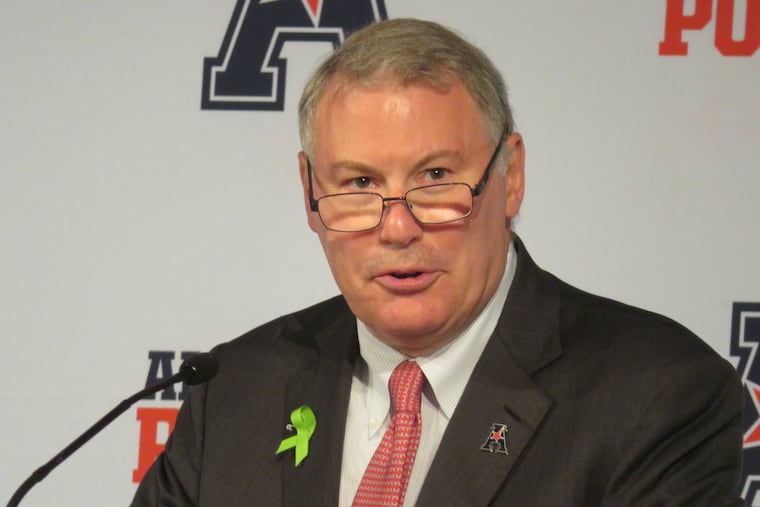AAC commissioner Mike Aresco talks about football’s potential return
Aresco admits that there are still many hurdles to clear, but he says he is cautiously optimistic that things are moving in the right direction.

Mike Aresco, the commissioner of the American Athletic Conference, of which Temple is a member, remains cautiously optimistic there will be a college football season. In an interview on Friday with The Inquirer, Aresco said there are still many hurdles that have to be cleared to have a college football season and especially one that starts on time.
The NCAA recently announced that voluntary on-campus activities can resume in football and basketball beginning on Monday. That is contingent on what a state rules and then school rules. The Philadelphia region is currently in restrictive Red Phase, which prohibits such activity.
While Aresco is commissioner in all AAC sports, the conversation was limited to football, which fields 11 teams. Some of the answers were edited for brevity.
Question: Will it be an AAC decision, a collaborative decision by all college football conferences, an NCAA decision, or all of the above whether football will return?
Answer: Right now, it looks like it’s going to be up to the individual conferences as to when they play based on, obviously, the state and local guidelines. We’re going to take the best practices and medical advice from our own medical advisory group, from the CDC, the NCAA Medical Advisory Group, but if we get the green light from those groups and the feeling is that we will at this point, it looks like the NCAA has basically said it is up to the conferences individually to make that decision. And we’re trying to work toward a consensus with P-5 (Power 5) and G-5 (Non-power five schools) in terms of FBS football. We’re hoping that we can start the season, on time or at least at the same time. Also, as you know, there might be some schools that can’t start when other schools can start. So we might have to some extent, a staggered schedule. I think our conference is still weighing that.
Q: What if all the schools aren’t able to play, whether because of state or school regulations, where do you weigh on that scenario?
A: If certain schools, for whatever reason, can not play this season and we hope that isn’t the case, but would we play with eight, nine, or 10 of those schools? I think the strong inclination of our conference -- we have not made a final decision -- would be to play. Those are the kinds of questions that we don’t have answers yet, but we will have them soon because obviously with June now being the reopening for voluntary workouts, we’re going to get a pretty good idea in June whether we can manage this successfully in terms of health and safety, and we think we can.
Q: How late can you put off making a final decision if you want the season to start on time? (Week Zero is Aug. 29 and Temple is scheduled to open Week One on Sept. 5 at Miami).
A: If you are going to start on time, you probably have to get formal practices started in mid-July. It’s going to take about six weeks because you’ve got kids who have not had the opportunity to play spring football, not necessarily had the kind of weight training and other things. You don’t want to have catastrophic injuries as a result of trying to get back too soon and that’s why the feeling was six weeks. And if some can’t, then what do you do with them? That’s the question. Do you start your season? Do you wait for others? You know we haven’t made ironclad decisions yet, but we’ve got a pretty good idea of what we’re going to do. And the other thing, too, is, June is going to give us a really good template, a good preview of whether we can implement a lot of our protocols, for health and safety effectively.
Q: If football returns in the fall, is there any chance fans can attend games?
A: It seems possible. Right now, no one knows yet. AD’s are looking at how they could do this, how they could reconfigure their stadium, what protocols they would have to put in place. If the states, for instance, allow 25% capacity or 50% capacity, the question is going to be: Can you do it safely, can you do the social distancing you need to do? How do you make sure that the players, coaches, and officials who have been tested, stay in what we call the protective bubble? So we don’t want to have an interaction with fans who obviously have not been tested, but our schools are looking at that and certainly the goal would be to try to get some fans into the stands. We don’t know yet whether that’s going to be possible."